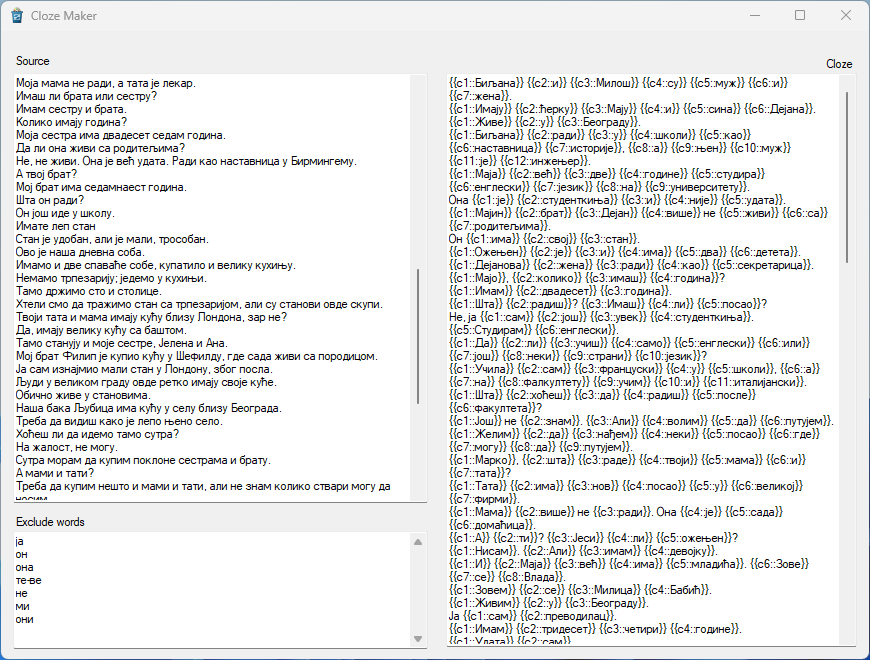Fri, Jun 30, 2023
ClozeMaker is a small Windows application I threw together in 2017 to make the process of making cloze-deletion flashcards in Anki easier. I demonstrated how I make these flashcards in a stream on YouTube:
Fri, Apr 29, 2016
This page contains files and links referred to in my Polyglot Gathering 2016 presentation.
Video of the presentation
Slides
Anki 2.0, Esperanto, and GitHub
Tue, Apr 24, 2012
Recently, I had become aware that Anki 2.0 was in beta through my friend Tom, who is working on making some changes to the MCD Support plugin so that it supports languages like Spanish as well as it does Japanese. Despite this awareness, it never crossed my mind that I might need to update the Esperanto Support addon that I wrote a couple years ago until I received an email from Damien Elmes, the author of Anki, that it was time to look at doing so.
Exporting Terms to Anki from Learning With Texts
Fri, Jan 27, 2012
This post was originally posted on Babelhut.
If you’ve been keeping up with the language learning scene online, you have probably heard of Learning With Texts (LWT), which is software to assist you in studying foreign language text. If this is the first you’ve heard of it, then I recommend checking out Benny’s excellent introduction to Learning With Texts , because the rest of this post won’t mean much to you if you are unfamiliar with it. This article also assumes you are aware of Anki , so if you’re not then you should read this introduction to Anki and Spaced Repetition and forget about forgetting ever again.
The Wonder of Critical Frequency
Fri, Jan 7, 2011
This post was originally posted on Babelhut.
About two weeks ago, in an effort to increase my Esperanto vocabulary, I signed up for lernu.net’s Vorto de la Tago (Word of the Day) service, which sends a daily email with, you guessed it, the word of the day. These emails are great for SRS because they include quite a few example sentences. The definitions are also monolingual (Esperanto-only, no English translations), which I think is a good thing because I notice that when I read Esperanto text I translate it to English mentally, thus slowing me down. So now I have these great daily reminders to add some new sentences to my SRS, and they’re forcing me to use the language to describe itself rather than using the crutch called English. And what did I do with these fantastic reminders?
Esperanto Support Plugin for Anki
Thu, Aug 5, 2010
So I decided to learn Esperanto, which as an avid user of the SRS application Anki, meant I needed to either enter Esperanto’s special characters (ĉ, ĝ, ĥ, ĵ, ŝ, ŭ) into my flash cards, which can’t easily be typed with the US International keyboard layout, or I could deal with the ugly “x method” workaround (cx, gx, hx, jx, sx, ux). At first, I was only creating Esperanto cards from my Linux computers at home, which let me use an Esperanto keyboard layout to type in the special characters. Pretty soon though, I found myself creating cards from my Windows machine at work during breaks. There is no Esperanto keyboard layout in Windows by default, so I tried to install some third party keyboard layouts without success. I eventually came across a program called Ek, which seemed to do the job of letting me type special characters, except in Anki where it would only type “ĉ”. So I just dealt with the “x method” and was typing words like vojagxas instead of vojaĝas. I don’t know why, but after a while all the x’s began to really bother me. I didn’t want to see mangxi in my flash cards, it just doesn’t seem as natural as manĝi does. So I did what any other software developer would do….
Recovering from a period of demotivation
Fri, Oct 24, 2008
This post was originally posted on Babelhut.
I need to make a confession. Over the past month or two, I’ve not been studying Spanish or any other language as I should. I found myself neglecting my SRS for up to a couple of weeks at a time. I was not studying any new material. I was not playing My Spanish Coach on my Nintendo DS and I was not listening to any of the Spanish podcasts that I had subscribed to. I was not watching Spanish television and I was not practicing speaking and listening with my Spanish-speaking friends.
